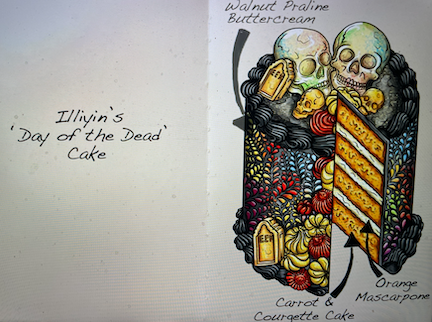More than just Halloween: embracing global autumn festivals.
- Julia Vogado
- Oct 31, 2024
- 6 min read
This week The Great British Bake Off had Autumn week and for the Autumn Festival showstopper challenge, a few of the creations were based on Autumn festivals from around the world. I watched as contestants paid homage to Día de los Muertos, Diwali, Samhain and St. Martin's Day, explaining cultural references and language skills as they went. It was good to see, especially in light of previous years, when international-themed episodes faced criticism for using cultural clichés, limited references and poor pronunciation - most notably Mexican Week (GBBO 2022) which sparked a lot of backlash (ponchos and tacos anyone?!).
While there have been clear mistakes in the past, this week’s GBBO episode demonstrated that there’s real potential for respectful and insightful engagement with global cultures, all the more so when individuals bring their own cultural influences into their work. Seeing a popular show reach millions of viewers across the UK and beyond, drawing attention to a wider range of autumnal traditions, shows that food and culture from around the world can be introduced meaningfully and creatively to audiences who may otherwise have limited exposure to these traditions.

(c) screenshot from Channel 4's GBBO show on 29/10/24
This exploration of diverse celebrations serves as a reminder of how exciting it can be to look outside our own traditions. Embracing new ideas, flavours, and rituals can make our lives richer and expand our perspective, just as learning new languages does. Traditions from around the world at this time of year offer unique insights into how people honour family, remember ancestors, and celebrate the harvest season. Further, when we engage with these practices, we broaden our repertoire of possibilities, adding to our own ways of celebrating and appreciating the season.
Halloween in the UK (as in the USA) is so widespread now, with its costumes, carved pumpkins, trick or treating, ever-more-elaborate and spookily-decorated shops, cafés and homes, and is increasingly celebrated worldwide, particularly in urban areas and amongst young people who love any excuse to dress up. However, in addition to this playful festival, across Europe and beyond, many other autumn traditions are observed. In southern Germany for example, perhaps even a predecessor to Halloween, they still celebrate "Rübengeistern" - carving ghost lamps from turnips, which can make for the scariest of sights, what with all the naturally ugly noses or warts offered up by misshapen vegetables! This tradition was born out of necessity after WW1, when, once harvest was over, labourers had no more work and families would go hungry until Christmas, hence the saying: "We are the turnip ghosts and have come to you. Give us something to eat, we are very hungry" - saying in German and details here.
One of my personal favourite autumn festivals is "La Castanyada" in Catalunya - which my family and I enjoyed while living in Barcelona. Originating from a need to provide warmth and sustenance, this cherished tradition focuses on eating roasted chestnuts and sweet potatoes served by castanyeras (chestnut ladies), sampling sweet panellets (extremely delicious, highly recommended and whilst every recipe differs, both these have delivered for us - see recipe in Spanish, recipe in English), and lots of singing, dancing - and sweet moscatel wine! Some nice detail about this festival here and a story for kids here. (We still make panellets every year, try to source chestnuts to roast at home and eat sweet potatoes in every form we can!).
All Saints' Day on 1/11 is a national holiday and a quiet day of remembrance in many Catholic nations, such as Spain ("Día de Todos los Santos"), France ("La Toussaint") and Italy ("Ognissanti"), as well as in Austria and the Catholic Bundesländer of Germany and Switzerland ("Allerheiligen"), where the tradition of gathering with friends and family to visit graves of loved ones is still widely observed. Flowers are usually offered, specifically chrysanthemums (for eternity) in France - and by the way, this is why you should avoid gifting this beautiful flower at any other time! All Souls' Day is usually recognised in all these regions too, but without the day off. "La fête des morts" in the French overseas territories such as Martinique is a combination of both, but sunnier and more vibrant.
Further afield, Mexico’s "Día de los Muertos" (Day of the Dead) has to be the second most globally recognised autumn festival of them all, standing out for its vibrancy and spiritual significance, although there is much more to it than the painted skulls and El Catrín/La Catrína costumes adopted in the UK. Across Mexico, families and friends gather to remember, honour and commune with their dearly departed, whose spirits they believe return for a short while to spend time with them. As such, they set up altars adorned with marigolds, candles, photos and the favourite food of the deceased to welcome them. Far from being a sombre or spooky occasion, Día de los Muertos is a real cause for celebration with colour, music, joy and stories, beginning on 31/10 when the 'angelitos' (spirits of deceased young) return (celebrated through 1/11, also known as "Día de los Inocentes/Angelitos") and on into 2/11 by when the spirits of deceased adults have arrived too. All in all, it highlights a life-affirming view of death and acts as a poignant reminder of the importance of family connections that transcend time. In the Andean countries of Bolivia, Ecuador and Peru, their celebration, "Día de los Difuntos", is a blend of indigenous and Catholic customs; they also visit cemeteries with friends and families, exchanging or offering food such as "guaguas de pan" / "T'anta wawas" (bread shaped like kids and animals).
As well as the honouring the dead and harvest, there are other origins for festivals at this time of year too, eg:
in Protestant parts of Germany and Switzerland they celebrate "Reformationstag" on 31/10 - to commemorate the beginning of Protestant Reformation, with tours and enactments, although chances are they'll be out at Halloween parties by the evening.
on 11/11, in many parts of Europe, including Northern France, Belgium, the Netherlands, Austria, Germany and Switzerland, St. Martin's Day will be celebrated in a style that seems to blend trick-or-treating with carol singing and Guy Fawkes night. Kids take part in candle-lit processions, holding the paper lanterns they made in school, going from house to house where they sing to get sweets, often ending up at a big bonfire. In Germany, families will gather to eat roasted goose (Martinsgans) and enjoy "Weckmann" (or similar) sweet pastry people.
"Diwali", festival of light, celebrated mainly by Hindus and Indians across the Indian diaspora - which falls on Halloween this year - celebrates good over evil, light over dark, in the most visually poetic of ways, with a 'new year' style purge in which homes are cleaned and new clothes are bought to maximise positive energy from the festival.
The wonderful thing about being aware of these and so many other festivals and traditions, is that they not only give us valuable insight into how people around the world honour and celebrate this season (no matter how much Halloween has crept in too), they also add richness and depth to our own options and give us new ways to connect with others and with other cultures. Maybe you’re intrigued by the idea of baking panellets with kids, welcoming the spirits of deceased loved ones in a more joyous way, or getting your kids to sing for their (inevitable) sweets haul rather than scaring people? There’s no single 'right way' to mark this season but each tradition offers something unique, giving us all a wider lens through which to appreciate and celebrate. So, whether you’re enjoying Halloween or trying something new this year, remember just how much choice and variety we have - just please avoid stereotypes!
At All Abroad! Bus, we aim to spark curiosity and bring global traditions to life, allowing participants to engage authentically and experience the world beyond their borders. Importantly, as we explore diverse cultures and customs, we ensure that we approach them thoughtfully and with genuine respect for those who practice them, creating enriching experiences that encourage appreciation, not appropriation, and deepen respect for the roots of each unique celebration.
If you would like to partner with us to create an autumn immersive experience from abroad, or if you are interested in us bringing our immersive language and culture experiences to you, please explore this website, browse our current menu of Experiences and get in touch to discuss a visit!











Comments